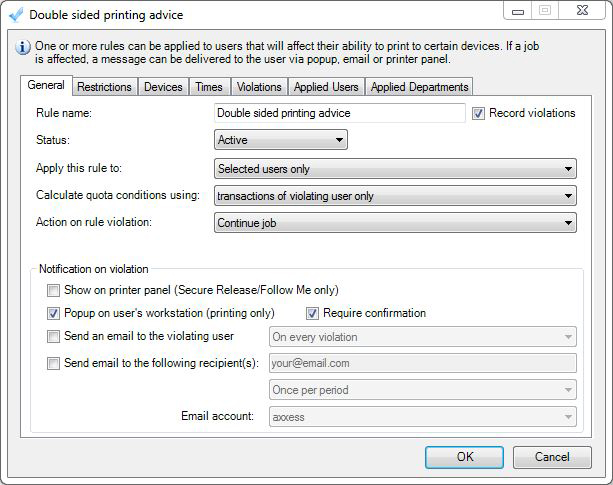How to educate users in double sided printing savings
The purpose of this Rule is not to place any limits on users’ ability to print single sided. It is only to educate them on the benefits of printing double sided. It will give them the option to cancel their job and re-print it double sided, after showing them a message regarding the savings.
This Rule assumes that all users have the PDAgent installed on their workstations. This is required in order for the popup window to be displayed.
Create a Rule
- Open Resource Manager.
- In the tree view, click Rules.
- On the right hand side, click the Add button.
- In the Rule name text box, under the General tab, enter Double sided printing advice (or any descriptive name you like).
- Change the Apply this rule to drop down to Selected users only (or if you want it to immediately apply to all users, choose All users with exclusions).
- Change the Calculate quota conditions using drop down to transactions of violating user only.
- Change the Action on rule violation to Message only, continue job (only applies to printing).
- In the Notification on violation frame, tick the Popup on user’s workstation (printing only) checkbox (so the user gets an immediate popup on their workstation).
- Adjacent to this, tick the box Require confirmation which will enable the user to cancel the job and reprint.

- Click the Restrictions tab.
- Select the Allow printing on the selected devices with conditions from the Print/copy option.
- Click the Simplex Printing tab, select the Single sided printing will incur a violation option.
- Change the Effective period drop down to per job.
- Change the Message if violated text to If you cancel and reprint this job as double-sided, you will save half the sheets of paper (put in whatever message you want the user to see).

- Click the Devices tab.
- Change the option to All devices.
- Click OK.
Apply the Rule to a user or users
This is only necessary if you chose Selected users only from the Apply this rule to drop down. Otherwise the Rule will be applied to all users anyway.
To apply the rule to a whole Department, skip to the next section.
- Open Resource Manager.
- Navigate User Management > Users.
- On the right, select the user (or multi-select users) and click Edit.
- Click the Rules tab.
- Select the Rule(s) to apply to the user. If more than one user was selected, tick the box to the left of the list of rules to enable it.
- Click OK.
Apply the Rule to a Department or Departments
Note that applying a Rule to a Department will not affect current members of the Department. It is a New User Default. This means that newly created users that are added to this Department will inherit the Rule. You can apply the Rule to current members by clicking the Go button (see below).
- Open Resource Manager.
- Navigate User Management > Departments.
- On the right, select the department (or multi-select) and click Edit.
- Click the Rules tab.
- Select the Rule(s) that will be the New User Default for the Department. If more than one Department was selected, tick the box to the left of the list of rules to enable it.
- In order to apply this Rule to the current members of the Department, click the Go button in the Current Members frame.
- In order to apply this Rule to the current members of the Department, click the Go button in the Current Members frame.
- Click OK.
Refresh PDServers and PDAgents
Now that a Rule setting has been changed, the PDServers and PDAgents will apply the setting when they next refresh from the database. By default, this happens every 10 minutes. To force a refresh immediately, follow these steps:
- On the left, click the PD Servers node.
- On the right, highlight all the servers. Right click and choose Refresh.
- Now click the PDAgents node.
- On the right, highlight all the servers. Right click and choose Refresh.
|
Document revision date: 2024/07/16 |


